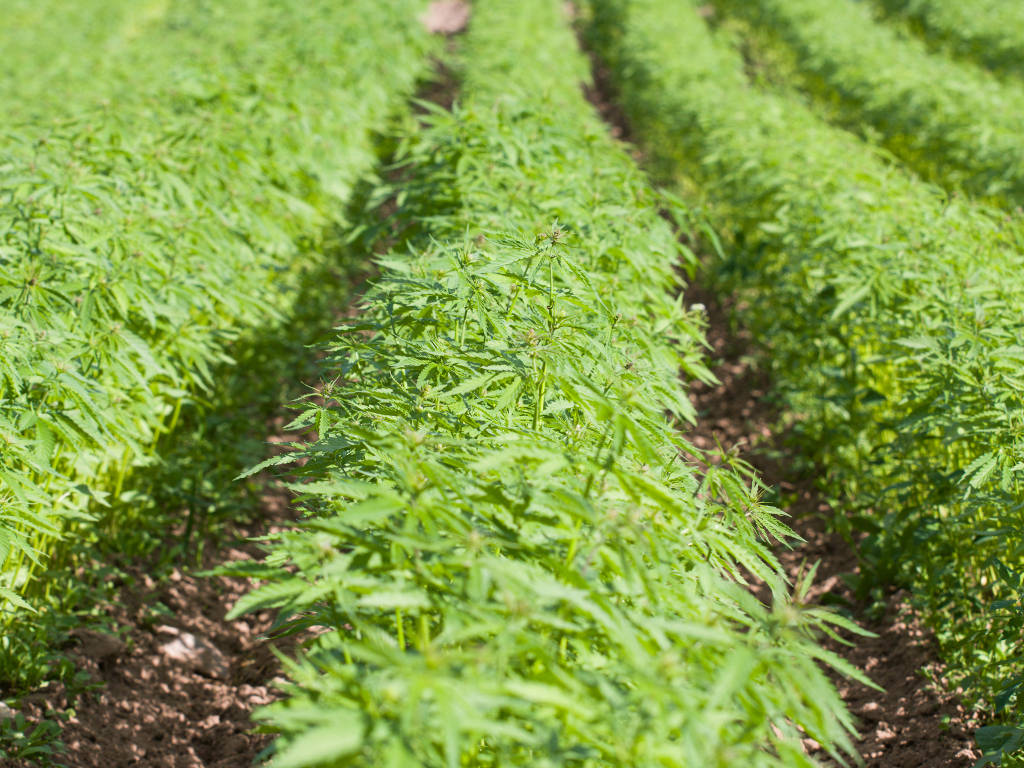Industrial cannabis up to four times more profitable than conventional crops – Wide range of use and big exporting potential provide opportunity for Serbian agriculturists
(Illustration) Industrial cannabis is increasingly more present in Serbian fields, and agricultural producers and experts believe that the trend of growth will continue, given its wide range of use, as well as its competitiveness in the market and its exporting potential.
According to the data by the Ministry of Agriculture and Environmental Protection, based on issued permits for growing cannabis, it was planed on around 172 hectares in Serbia in 2016, of which 90% in Vojvodina. In the first months of 2017, plantations on more than 100 hectares were registered, and, as the Association of Crop Production of the Chamber of Commerce of Serbia (CCIS) says for eKapija, there`s been an increase in areas under cannabis, as well as the number of registered producers, in the past four years, indicating that agriculturists have found their interest in growing this industrial plant.
The biggest challenges to further increasing the areas, however, will lie in educating agriculturists and in the legislative, which needs to be amended in order to increase the possibility of processing cannabis and exporting the derivative products. To that end, according to the CCIS, a draft law on amendments to the Law on Psychoactive Controlled Substances, which regulates the cultivation of this plant.
The initiative for amending the law, that is, the regulation on conditions for growing cannabis, has also been started by the Association of Producers and Processors of Alternative Species “Hemp”, as it limits the production for industrial needs, according to them. The debate mostly focuses on the plants health and safety impact, whereas its market value should be considered as well.
As Maja Timotijevic, the president of the association, says, it`s important to expand the range of sorts, as the EU allows growing 46 sorts of cannabis, whereas Serbia only allows three. The permits are issued for a period of a year.
– Both types of cannabis currently have the same legal status, and our demands pertain to a more liberal attitude towards the plant whose level of psychoactive substance THC is within the legal percentage – up to 0.3%. This way, we would help agricultural producers who still have prejudices towards it, as the law itself is insufficiently clear. We hope that our suggestions will be adopted – Maja Timotijevic points out in her interview for eKapija.
Opportunity for small farms
According to the data by the Ministry of Agriculture and Environmental Protection, based on issued permits for growing cannabis, it was planed on around 172 hectares in Serbia in 2016, of which 90% in Vojvodina. In the first months of 2017, plantations on more than 100 hectares were registered, and, as the Association of Crop Production of the Chamber of Commerce of Serbia (CCIS) says for eKapija, there`s been an increase in areas under cannabis, as well as the number of registered producers, in the past four years, indicating that agriculturists have found their interest in growing this industrial plant.
The biggest challenges to further increasing the areas, however, will lie in educating agriculturists and in the legislative, which needs to be amended in order to increase the possibility of processing cannabis and exporting the derivative products. To that end, according to the CCIS, a draft law on amendments to the Law on Psychoactive Controlled Substances, which regulates the cultivation of this plant.
The initiative for amending the law, that is, the regulation on conditions for growing cannabis, has also been started by the Association of Producers and Processors of Alternative Species “Hemp”, as it limits the production for industrial needs, according to them. The debate mostly focuses on the plants health and safety impact, whereas its market value should be considered as well.
As Maja Timotijevic, the president of the association, says, it`s important to expand the range of sorts, as the EU allows growing 46 sorts of cannabis, whereas Serbia only allows three. The permits are issued for a period of a year.
– Both types of cannabis currently have the same legal status, and our demands pertain to a more liberal attitude towards the plant whose level of psychoactive substance THC is within the legal percentage – up to 0.3%. This way, we would help agricultural producers who still have prejudices towards it, as the law itself is insufficiently clear. We hope that our suggestions will be adopted – Maja Timotijevic points out in her interview for eKapija.
Opportunity for small farms
The association, founded two years ago, believes that they will be able to say in 5 to 10 years that the goal has been achieved – to have cannabis planted on more than 10,000 hectares, as the growth has been apparent so far.
– Industrial cannabis is an annual plant which is sown in April and May and harvested as soon as September. The most important thing is that it is an ecological plant which doesn`t require any chemical substances and its green mass is very significant, as it produces more than 10 tons per hectare. A hectare of cannabis produces the same amount of fiber as four hectares of a forest or two hectares of cotton. It`s also important that all parts of the plant are used: stems, flowers, leaves, fruits, even the root – Timotijevic explains and adds that growing cannabis bring great benefits to agricultural producers and increases their competitiveness in the market.
She believes that growing industrial cannabis is a great opportunity for small family farms, but also medium-sized ones, as yields more than four times bigger than those of conventional crops can be made on small areas. She also says that there more and more potential investors contacting them.
Petar Latkovic, a farmer from Temerin, also highlights the plant`s great potential. In his interview for eKapija, he says that the processing of cannabis increases the value of products up to ten times, and that the possibilities of implementation are numerous. It can be used for the production of pellets for heating, fish meal, boat ropes, even as construction material.
– This is a product that sells easily and has great exporting potential, and the state could therefore benefit as well. Us producers could use support from that end, especially for procuring sowing mechanization – Latkovic notes and adds that the question of buyout has not yeat been solved and that products need to be sent to laboratories to be examined regularly.
He estimates that the state is currently unwilling to engage more and support the producers of industrial cannabis, and he believes that one of the reasons is the pressure from various lobbies and the pharmaceutical industry.
Wide range of products and use
More than 20,000 products can be made from industrial cannabis, and the Agricultural Cooperative “Hemp” has produced around ten finished products in 2017, which, as Timotijevic points out, they are especially proud of, as they believe that primary products shouldn`t be exported, but processed and then offered to the European and global market.
– Industrial cannabis is an annual plant which is sown in April and May and harvested as soon as September. The most important thing is that it is an ecological plant which doesn`t require any chemical substances and its green mass is very significant, as it produces more than 10 tons per hectare. A hectare of cannabis produces the same amount of fiber as four hectares of a forest or two hectares of cotton. It`s also important that all parts of the plant are used: stems, flowers, leaves, fruits, even the root – Timotijevic explains and adds that growing cannabis bring great benefits to agricultural producers and increases their competitiveness in the market.
She believes that growing industrial cannabis is a great opportunity for small family farms, but also medium-sized ones, as yields more than four times bigger than those of conventional crops can be made on small areas. She also says that there more and more potential investors contacting them.
Petar Latkovic, a farmer from Temerin, also highlights the plant`s great potential. In his interview for eKapija, he says that the processing of cannabis increases the value of products up to ten times, and that the possibilities of implementation are numerous. It can be used for the production of pellets for heating, fish meal, boat ropes, even as construction material.
– This is a product that sells easily and has great exporting potential, and the state could therefore benefit as well. Us producers could use support from that end, especially for procuring sowing mechanization – Latkovic notes and adds that the question of buyout has not yeat been solved and that products need to be sent to laboratories to be examined regularly.
He estimates that the state is currently unwilling to engage more and support the producers of industrial cannabis, and he believes that one of the reasons is the pressure from various lobbies and the pharmaceutical industry.
Wide range of products and use
More than 20,000 products can be made from industrial cannabis, and the Agricultural Cooperative “Hemp” has produced around ten finished products in 2017, which, as Timotijevic points out, they are especially proud of, as they believe that primary products shouldn`t be exported, but processed and then offered to the European and global market.
– The products available include cold-pressed seed oil, flour, proteins, cannabis oil-based soaps and several cosmetic products, and we also expect CBD oil to appear soon, a very rare and valuable product in the market. These are 100% natural, Serbian-made products, and the Gramina brand is synonymous with tested, natural products, which is what we aim for – eKapija`s interviewee explains.
The expansion of growing cannabis for various purposes is apparent globally as well.
– It`s important in the textile industry, the food industry, the pharmaceutical industry, the paper industry, cosmetics, construction, environmental protection... Industrial use of cannabis is spreading remarkably quickly in the production of biocomposite materials for the automotive industry and biodegradable plastic as well – Timotijevic adds.
The biggest global producers of industrial cannabis are China, Russia and Canada, whereas Europe features several countries producing considerable amounts – France, Germany, Austria, Spain, Holland, Hungary, Poland, Romania and Croatia. EU plans to have cannabis planted on more than 100,000 hectares by 2030, and the announcements are in line with the data by the European Industrial hemp Association, sent to eKapija by the CCIS. In 2016, there were 30,000 hectares under cannabis in the EU, and the biggest increase in processing took place in the food industry, which is also one of the main reasons for increased production of hemp seeds.
CCIS reminds that former Yugoslavia was one of the leading global producers of cannabis and that, in 1988, there were 288,000 hectares under the plant, grown for its fiber.
M.A.
The expansion of growing cannabis for various purposes is apparent globally as well.
– It`s important in the textile industry, the food industry, the pharmaceutical industry, the paper industry, cosmetics, construction, environmental protection... Industrial use of cannabis is spreading remarkably quickly in the production of biocomposite materials for the automotive industry and biodegradable plastic as well – Timotijevic adds.
The biggest global producers of industrial cannabis are China, Russia and Canada, whereas Europe features several countries producing considerable amounts – France, Germany, Austria, Spain, Holland, Hungary, Poland, Romania and Croatia. EU plans to have cannabis planted on more than 100,000 hectares by 2030, and the announcements are in line with the data by the European Industrial hemp Association, sent to eKapija by the CCIS. In 2016, there were 30,000 hectares under cannabis in the EU, and the biggest increase in processing took place in the food industry, which is also one of the main reasons for increased production of hemp seeds.
CCIS reminds that former Yugoslavia was one of the leading global producers of cannabis and that, in 1988, there were 288,000 hectares under the plant, grown for its fiber.
M.A.
Companies:
Ministarstvo poljoprivrede, šumarstva i vodoprivrede Republike Srbije
Privredna komora Srbije
Tags:
Share:






Only logged-in users can comment.


 Izdanje Srbija
Izdanje Srbija Serbische Ausgabe
Serbische Ausgabe Izdanje BiH
Izdanje BiH Izdanje Crna Gora
Izdanje Crna Gora


 News
News









 LinkedIn
LinkedIn Copy link
Copy link



